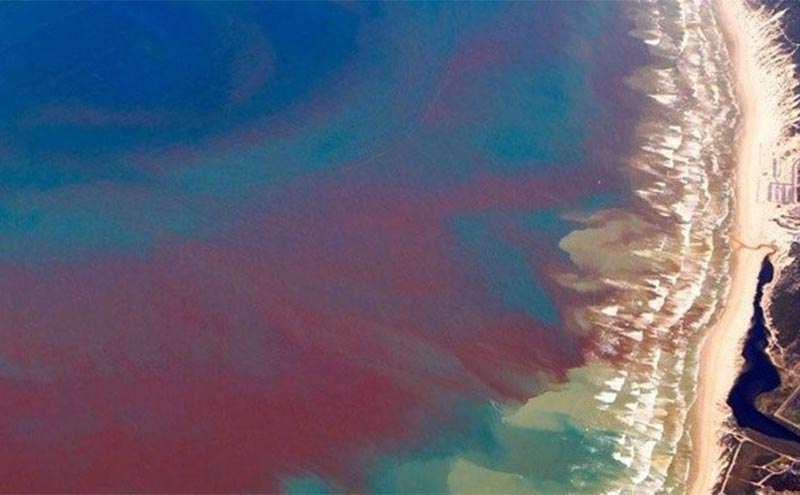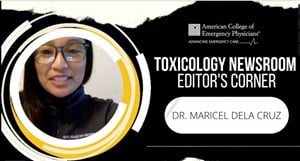
Red Tides: The Phenomenon That Will Take Your Breath Away
(Image above comes from wmbfnews.com)
Emergency Medicine Residents’ Association, Toxicology Committee Leadership Team
Introduction
Red tides are harmful algal blooms (HABs) that occur along coastal regions. They result from large accumulation of aquatic microorganisms, such as protozoans and unicellular algae.1,2 These toxins can kill fish, make shellfish dangerous to eat, and make the surrounding air difficult to breathe for humans and animals. As the name implies, the bloom of algae often turns the water red. In humans, a red tide can cause respiratory irritation, and of course, deter tourists looking to enjoy the local beaches.3
The human health effects associated with eating brevetoxin-tainted shellfish are well documented.4 However, scientists are still obtaining knowledge about how other types of environmental exposures to brevetoxin—such as breathing the air near red tides or swimming in red tides—may affect humans.5 In the era of COVID-19, understanding impacts of environmental exposures on those with underlying pulmonary disease is critical to public health safety.
Background
HABs have been reported in every United States coastal state, and their occurrence may be on the rise.6 HABs are a national concern because they affect not only the health of people and marine ecosystems, but also the health of local and regional economies. These high concentrations of algae most commonly occur off the central and southwestern coasts of Florida but may occur anywhere in the Gulf of Mexico. Blooms may also occur along the southeastern Atlantic coast as far north as North Carolina, but are less common.1,6
HABs have been under the national microscope in recent years. The most recent red tide event was in 2018, which was not only harmful to marine wildlife, but also to those enjoying the summertime beaches. This flare affected portions of the coasts of Florida between 2017-2018. It persisted on the southwest coast beginning in October 2017 and spread to the Panhandle and the east coast of Florida.1,3 Although it may seem like a new phenomenon, red tides have been documented in the southern Gulf of Mexico as far back as the 1700s and along Florida's Gulf coast in the 1840s. Fish kills near Tampa Bay were even mentioned in the records of Spanish explorers in the 1500s.3
The blooms are most often composed of the marine microalgae, Karenia brevis (K. brevis).2,3 It is a marine dinoflagellate that produces highly potent natural polyether toxins, called brevetoxins.2,4 They are sodium channel neurotoxins, and possibly act as histamine activators, that can induce adverse pulmonary responses when aerosolized and subsequently inhaled by marine animals or humans.2 In experimental animals, brevetoxins cause significant bronchoconstriction.7
Individuals exposed in areas with red tide events exhibit a variety of upper and lower respiratory symptoms including coughing, sneezing, rhinorrhea, and bronchoconstriction.8,9 Exposure to brevetoxins has been shown to induce more severe respiratory effects in individuals with asthma.8 Similarly, studies using animal models of non-asthmatic sheep and sheep with allergic asthma demonstrated a nonspecific increase in airway hyperresponsiveness with brevetoxin exposure. This effect was blocked using several pharmacological agents, including the mast cell stabilizer, cromolyn sodium, and the histamine H1-antagonist, diphenhydramine, indicating the role of mast cells in brevetoxin pulmonary toxicity.7,10
A Public Health Concern
HABs threaten the health not only of the surrounding environment, but also of those who inhabit the locations. It is important to keep this toxic source on the differential list when caring for patients presenting with respiratory complaints. As asthma increases in incidence in the United States, there is increasing concern over environmental exposures that may trigger asthma exacerbations.
According to the CDC, asthma is a very common condition. One in 12 people had asthma in 2009, compared with 1 in 14 (about 20 million, or 7%) in 2001. Asthma cost the United States about $3,300 per person with asthma each year from 2002 to 2007 in medical expenses. Asthma not only imparts a financial burden of medical costs, but it also has an economic and educational strain on those affected. More than half (59%) of children and one-third (33%) of adults who had an asthma attack missed school or work because of asthma in 2008. On average, in 2008 children missed 4 days of school and adults missed 5 days of work because of asthma.11
The public health challenge is to provide timely protective information for resident and tourist populations about the exposures and health effects of red tide. In a unique collaboration, the Florida Department of Health (FDOH), CDC, NOAA, and public and private partners have established a linked network of public health information resources, exposure, and disease surveillance on red tide.7,12 With such collaborations, affected populations will be better able to protect themselves from a potentially expensive and life-threatening respiratory decompensation.
Clinical Presentation
The consumption of shellfish that have been exposed to brevetoxin results in neurotoxic shellfish poisoning, characterized by gastrointestinal and neurologic symptoms.13 The victims of these poisonings are usually birds, mammals, and humans. In both birds and smaller mammals, this poisoning is usually fatal, but in humans it is usually just debilitating.3,14
Potential exposure resulting in toxicity can also occur from skin contact, water ingestion, or inhalation of water vapor in areas affected by red tides.2,15 Brevetoxin within red tides may be aerosolized by rough seas or breaking waves.16 Patients may note that the air had a sulfurous scent. Clinical effects may present soon after exposure and include fever, headache, rash, eye irritation, myalgias, vomiting, diarrhea, respiratory distress, wheezing, and neurologic symptoms (e.g., paresthesias or confusion).17 Given the nonspecific nature of the presentation, the clinician must have a high degree of suspicion, especially in patients with unexplained neurologic findings, and ask about exposure to water to make the diagnosis.
With toxicological exposures, the severity of symptoms typically depends on length of time exposed and concentration of agent. If a patient was exposed via consuming contaminated seafood, symptom onset can take up to a few days to fully display. However, it is more typical to experience acute symptom onset in the initial hours of exposure.
The human health effects associated with eating brevetoxin-tainted shellfish are well documented.5,13 However, scientists are still obtaining knowledge about how other types of environmental exposures to brevetoxin—such as breathing the air near red tides or swimming in red tides—may affect humans. Anecdotal evidence suggests that people who swim among brevetoxins or inhale brevetoxins dispersed in the air may experience irritation of the eyes, nose, and throat, as well as coughing, wheezing, and shortness of breath. Additional evidence suggests that people with existing respiratory illness (e.g. asthma) may experience these symptoms more severely. 3–5,10
The acute management of patients with brevetoxin exposure includes removing the patient from exposure, minimizing subsequent exposures, and symptomatic and supportive care. Patients suspected of toxicity from HABs should also be reported to the local department of public health to encourage investigation of the water source and importance of investigative groups.
Conclusion
Coastal inhabitants are at risk of exposure to HABs. Although ingestion exposures have been well documented and understood, there is significant risk for these toxins to be aerosolized and cause respiratory distress. Humans, pets, and wildlife are all at risk, especially humans with underlying respiratory disease. In the age of COVID-19, it would be an interesting area to research if those who have recovered from COVID, if they have residual underlying lung disease that puts them in a similar risk category as asthmatics. If a patient presents with a suspected exposure, they can have a wide range of presenting symptoms including skin irritation, gastrointestinal compromise, neurological compromise, or respiratory distress. As HABs have been documented in every coastal state, it is important for toxicologists to keep HABs in mind as a source of exposure when caring for the undifferentiated patient.
Take Home Points
- HABs or “red tides” pose a unique threat to surrounding humans and wildlife
- The most common culprit is the marine microalgae brevis that produces highly potent brevetoxins
- These toxins can induce adverse pulmonary responses when aerosolized and subsequently inhaled by marine animals or humans
- Individuals with underlying respiratory disease such as asthma, emphysema, or COVID may be at increased risk for respiratory decompensation
- Patients suspected of toxicity from HABs should be removed from the exposure and managed with symptomatic and supportive care
- Patients suspected of toxicity from HABs should also be reported to the local department of public health to encourage investigation of the body of water and prevent further exposures
References
- About Red Tides in Florida. Florida Fish And Wildlife Conservation Commission. Accessed September 10, 2021. Learn More
- Adams ET, Adler R, Alden CL, et al. Contributors. In: Haschek WM, Rousseaux CG, Wallig MA, eds. Haschek and Rousseaux’s Handbook of Toxicologic Pathology (Third Edition). Academic Press; 2013:xxxiii-xxxvi. doi:10.1016/B978-0-12-415759-0.01004-9
- Pierce RH, Henry MS. Harmful algal toxins of the Florida red tide (Karenia brevis): natural chemical stressors in South Florida coastal ecosystems. Ecotoxicol Lond Engl. 2008;17(7):623-631. doi:10.1007/s10646-008-0241-x
- Poli MA, Musser SM, Dickey RW, Eilers PP, Hall S. Neurotoxic shellfish poisoning and brevetoxin metabolites: a case study from Florida. Toxicon Off J Int Soc Toxinology. 2000;38(7):981-993. doi:10.1016/s0041-0101(99)00191-9
- Illness and Symptoms: Marine (Saltwater) Algal Blooms | Harmful Algal Blooms | CDC. Published April 19, 2021. Accessed September 10, 2021. Learn More
- US Department of Commerce NO and AA. What is a red tide? Accessed September 10, 2021. Learn More
- Human-Animal Medicine - 1st Edition. Accessed September 10, 2021. Learn More
- Fleming LE, Kirkpatrick B, Backer LC, et al. Initial Evaluation of the Effects of Aerosolized Florida Red Tide Toxins (Brevetoxins) in Persons with Asthma. Environ Health Perspect. 2005;113(5):650-657. doi:10.1289/ehp.7500
- Trigger control to enhance asthma management - UpToDate. Accessed September 10, 2021. Learn More
- Parent RA, ed. Appendix 6 - Aging of the Normal Lung. In: Comparative Biology of the Normal Lung (Second Edition). Academic Press; 2015:777-780. doi:10.1016/B978-0-12-404577-4.15006-4
- CDC. CDC Vital Signs - Asthma in the US. Centers for Disease Control and Prevention. Published May 3, 2011. Accessed September 10, 2021. Learn More
- US Department of Commerce NO and AA. Gulf of Mexico: Harmful Algal Blooms. Accessed September 10, 2021. Learn More
- James KJ, Carey B, O’Halloran J, Pelt F, Skrabáková Z. Shellfish toxicity: Human health implications of marine algal toxins. Epidemiol Infect. 2010;138:927-940. doi:10.1017/S0950268810000853
- Sobel J, Painter J. Illnesses caused by marine toxins. Clin Infect Dis Off Publ Infect Dis Soc Am. 2005;41(9):1290-1296. doi:10.1086/496926
- Friedman MA, Levin BE. Neurobehavioral effects of harmful algal bloom (HAB) toxins: a critical review. J Int Neuropsychol Soc JINS. 2005;11(3):331-338. doi:10.1017/S1355617705050381
- Current Therapy in Neurologic Disease - 7th Edition. Accessed September 10, 2021. Learn More
- Medline ® Abstract for Reference 3 of “Overview of shellfish and pufferfish poisoning” - UpToDate. Accessed September 10, 2021. Learn More
Alexa Peterson, DO MS
Nicholas Titelbaum, MD
Shelby Randall, DO
Katelynn Baska, DO
Nicole Ovregaard, MPH, MS-III



